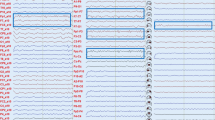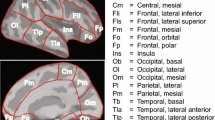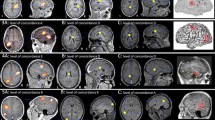Abstract
The clinical usefulness of electric source imaging (ESI) in presurgical epilepsy evaluation has now been demonstrated; however, its use in clinical routine remains somewhat limited. Here, we discuss the added clinical value of ESI and how its integration in the presurgical work-up of epilepsy patients can be optimized. We present methodological differences of ESI on interictal and ictal epileptic activity as well as their evaluation compared with intracranial EEG data. Beyond the choice of patterns used for ESI, the choice of inverse methods can have tremendous impact on source imaging results. It is of great clinical interest that during recent years several inverse methods have been developed that are sensitive to the spatial extent of the generators of epileptic activity. In this regard, we discuss the performance of different approaches. Advanced inverse methods that consider the temporal evolution of the EEG signal even allow for localizing deep generators with good spatial accuracy. In summary, recent methodological advances in ESI foster its application in clinical practice.
Zusammenfassung
Der Nutzen der Elektroenzephalogramm(EEG)-Quellenlokalisation („electric source imaging“, ESI) in der prächirurgischen Epilepsiediagnostik ist belegt, klinisch wird ESI allerdings weiterhin nur begrenzt eingesetzt. Innerhalb dieses Artikels werden Vorteile der ESI und ihre Integration in den klinischen Alltag vorgestellt. Es werden methodische Unterschiede zwischen ESI auf der Basis interiktaler und iktaler epileptischer Aktivität und die Validierung mit dem intrakraniellen EEG erörtert. Über die Auswahl der EEG-Muster hinaus kann die Wahl der inversen Methode entscheidenden Einfluss auf das ESI-Ergebnis haben. Von großem klinischem Interesse ist, dass in letzter Zeit inverse Methoden entwickelt wurden, die sensitiv für die Ausdehnung von Generatoren epileptischer Aktivität sind. In diesem Zusammenhang wird die Leistungsfähigkeit unterschiedlicher Methoden verglichen. Fortgeschrittene inverse Methoden sind zudem in der Lage, den zeitlichen Verlauf von EEG-Signalen zu berücksichtigen und auch von der Oberfläche weit entfernte, tiefe Generatoren epileptischer Aktivität mit guter räumlicher Auflösung zu lokalisieren. Zusammenfassend unterstützen neue methodische Entwicklungen die weitere klinische Anwendung von ESI.


Similar content being viewed by others
References
Michel CM, Murray MM, Lantz G, Gonzalez S, Spinelli L, Grave de Peralta R (2004) EEG source imaging. Clin Neurophysiol 115(10):2195–2222
Vulliemoz S, Lemieux L, Daunizeau J, Michel CM, Duncan JS (2010) The combination of EEG source imaging and EEG-correlated functional MRI to map epileptic networks. Epilepsia 51(4):491–505. https://doi.org/10.1111/j.1528-1167.2009.02342.x
Heers M, Hedrich T, An D et al (2014) Spatial correlation of hemodynamic changes related to interictal epileptic discharges with electric and magnetic source imaging. Hum Brain Mapp 35:4396–4414. https://doi.org/10.1002/hbm.22482
Mégevand P, Seeck M (2018) Electroencephalography, magnetoencephalography and source localization: their value in epilepsy. Curr Opin Neurol 31(2):176–183. https://doi.org/10.1097/WCO.0000000000000545
Mouthaan BE, Rados M, Barsi P et al (2016) Current use of imaging and electromagnetic source localization procedures in epilepsy surgery centers across Europe. Epilepsia 57:770–776. https://doi.org/10.1111/epi.13347
Plummer C, Harvey AS, Cook M (2008) EEG source localization in focal epilepsy: Where are we now? Epilepsia 49:201–218. https://doi.org/10.1111/j.1528-1167.2007.01381.x
Feng R, Hu J, Pan L et al (2016) Application of 256-channel dense array electroencephalographic source imaging in presurgical workup of temporal lobe epilepsy. Clin Neurophysiol. https://doi.org/10.1016/j.clinph.2015.03.009
Englot DJ, Nagarajan SS, Imber BS et al (2015) Epileptogenic zone localization using magnetoencephalography predicts seizure freedom in epilepsy surgery. Epilepsia. https://doi.org/10.1111/epi.13002
Lascano AM, Perneger T, Vulliemoz S et al (2016) Yield of MRI, high-density electric source imaging (HD-ESI), SPECT and PET in epilepsy surgery candidates. Clin Neurophysiol 127:150–155. https://doi.org/10.1016/j.clinph.2015.03.025
Knowlton RC, Elgavish RA, Bartolucci A et al (2008) Functional imaging: II. Prediction of epilepsy surgery outcome. Ann Neurol 64:35–41. https://doi.org/10.1002/ana.21419
Brodbeck V, Spinelli L, Lascano AM et al (2011) Electroencephalographic source imaging: a prospective study of 152 operated epileptic patients. Brain 134:2887–2897. https://doi.org/10.1093/brain/awr243
Abdallah C, Maillard LG, Rikir E et al (2017) Localizing value of electrical source imaging: frontal lobe, malformations of cortical development and negative MRI related epilepsies are the best candidates. Neuroimage Clin 16:319–329. https://doi.org/10.1016/J.NICL.2017.08.009
Mégevand P, Spinelli L, Genetti M et al (2014) Electric source imaging of interictal activity accurately localises the seizure onset zone. J Neurol Neurosurg Psychiatry 85:38–43. https://doi.org/10.1136/jnnp-2013-305515
Brodbeck V, Lascano AM, Spinelli L et al (2009) Accuracy of EEG source imaging of epileptic spikes in patients with large brain lesions. Clin Neurophysiol. https://doi.org/10.1016/j.clinph.2009.01.011
Brodbeck V, Spinelli L, Lascano AM et al (2010) Electrical source imaging for presurgical focus localization in epilepsy patients with normal MRI. Epilepsia. https://doi.org/10.1111/j.1528-1167.2010.02521.x
Lantz G, Grave de Peralta R, Spinelli L et al (2003) Epileptic source localization with high density EEG: How many electrodes are needed? Clin Neurophysiol 114:63–69. https://doi.org/10.1016/S1388-2457(02)00337-1
Song J, Davey C, Poulsen C et al (2015) EEG source localization: sensor density and head surface coverage. J Neurosci Methods 256:9–21. https://doi.org/10.1016/j.jneumeth.2015.08.015
Bach Justesen A, Eskelund Johansen AB, Martinussen NI et al (2018) Added clinical value of the inferior temporal EEG electrode chain. Clin Neurophysiol. https://doi.org/10.1016/j.clinph.2017.09.113
Seeck M, Koessler L, Bast T et al (2017) The standardized EEG electrode array of the IFCN. Clin Neurophysiol 128:2070–2077. https://doi.org/10.1016/j.clinph.2017.06.254
Lantz G, Spinelli L, Seeck M et al (2003) Propagation of interictal epileptiform activity can lead to erroneous source localizations: a 128-channel EEG mapping study. J Clin Neurophysiol 20:311–319
Mălîia MD, Meritam P, Scherg M et al (2016) Epileptiform discharge propagation: analyzing spikes from the onset to the peak. Clin Neurophysiol 127:2127–2133. https://doi.org/10.1016/j.clinph.2015.12.021
Scheuer ML, Bagic A, Wilson SB (2017) Spike detection: Inter-reader agreement and a statistical Turing test on a large data set. Clin Neurophysiol 128:243–250. https://doi.org/10.1016/j.clinph.2016.11.005
Birot G, Spinelli L, Vulliémoz S et al (2014) Head model and electrical source imaging: a study of 38 epileptic patients. Neuroimage Clin 5:77–83. https://doi.org/10.1016/j.nicl.2014.06.005
Vorwerk J, Cho JH, Rampp S et al (2014) A guideline for head volume conductor modeling in EEG and MEG. Neuroimage 100:590–607. https://doi.org/10.1016/j.neuroimage.2014.06.040
Brunet D, Murray MM, Michel CM (2011) Spatiotemporal analysis of multichannel EEG: CARTOOL. Comput Intell Neurosci. https://doi.org/10.1155/2011/813870
Oostenveld R, Fries P, Maris E, Schoffelen JM (2011) FieldTrip: open source software for advanced analysis of MEG, EEG, and invasive electrophysiological data. Comput Intell Neurosci. https://doi.org/10.1155/2011/156869
Tadel F, Baillet S, Mosher JC et al (2011) Brainstorm: a user-friendly application for MEG/EEG analysis. Comput Intell Neurosci. https://doi.org/10.1155/2011/879716
van Mierlo P, Strobbe G, Keereman V et al (2017) Automated long-term EEG analysis to localize the epileptogenic zone. Epilepsia Open. https://doi.org/10.1002/epi4.12066
Koessler L, Benar C, Maillard L et al (2010) Source localization of ictal epileptic activity investigated by high resolution EEG and validated by SEEG. Neuroimage. https://doi.org/10.1016/j.neuroimage.2010.02.067
Beniczky S, Lantz G, Rosenzweig I et al (2013) Source localization of rhythmic ictal EEG activity: a study of diagnostic accuracy following STARD criteria. Epilepsia. https://doi.org/10.1111/epi.12339
Nemtsas P, Birot G, Pittau F et al (2017) Source localization of ictal epileptic activity based on high-density scalp EEG data. Epilepsia. https://doi.org/10.1111/epi.13749
Lantz G, Michel CM, Seeck M et al (1999) Frequency domain EEG source localization of ictal epileptiform activity in patients with partial complex epilepsy of temporal lobe origin. Clin Neurophysiol. https://doi.org/10.1016/S0013-4694(98)00117-5
Pellegrino G, Hedrich T, Chowdhury R et al (2016) Source localization of the seizure onset zone from ictal EEG/MEG data. Hum Brain Mapp. https://doi.org/10.1002/hbm.23191
Mosher JC, Baillet S, Leahy RM (1999) EEG source localization and imaging using multiple signal classification approaches. J Clin Neurophysiol 16:225–238
Beniczky S, Oturai PS, Alving J et al (2006) Source analysis of epileptic discharges using multiple signal classification analysis. Neuroreport. https://doi.org/10.1097/01.wnr.0000230517.93714.f6
Gross J, Kujala J, Hamalainen M et al (2001) Dynamic imaging of coherent sources: studying neural interactions in the human brain. Proc Natl Acad Sci U S A 98:694–699. https://doi.org/10.1073/pnas.98.2.694
Elshoff L, Muthuraman M, Anwar AR et al (2013) Dynamic imaging of coherent sources reveals different network connectivity underlying the generation and perpetuation of epileptic seizures. PLoS ONE 8:1–11. https://doi.org/10.1371/journal.pone.0078422
Heers M, Hirschmann J, Jacobs J et al (2014) Frequency domain beamforming of magnetoencephalographic beta band activity in epilepsy patients with focal cortical dysplasia. Epilepsy Res 108:1195–1203. https://doi.org/10.1016/j.eplepsyres.2014.05.003
Pascual-Marqui RD (2002) Standardized low-resolution brain electromagnetic tomography (sLORETA): technical details. Methods Find Exp Clin Pharmacol 24(Suppl D):5–12
Epitashvili N, Schulze-Bonhage A, Dümpelmann M (2016) Source localization of ictal epileptic activity in patients with focal epilepsy validated with invasive EEG. Epilepsia 57(Suppl. 2):135. https://doi.org/10.1111/epi.13609
Cosandier-Rimélé D, Ramantani G, Zentner J et al (2017) A realistic multimodal modeling approach for the evaluation of distributed source analysis: application to sLORETA. J Neural Eng 14:56008. https://doi.org/10.1088/1741-2552/aa7db1
Ramantani G, Cosandier-Rimélé D, Schulze-Bonhage A et al (2013) Source reconstruction based on subdural EEG recordings adds to the presurgical evaluation in refractory frontal lobe epilepsy. Clin Neurophysiol. https://doi.org/10.1016/j.clinph.2012.09.001
Lanfer B, Scherg M, Dannhauer M et al (2012) Influences of skull segmentation inaccuracies on EEG source analysis. Neuroimage. https://doi.org/10.1016/j.neuroimage.2012.05.006
Lanfer B, Röer C, Scherg M et al (2013) Influence of a silastic ECoG grid on EEG/ECoG based source analysis. Brain Topogr. https://doi.org/10.1007/s10548-012-0251-0
von Ellenrieder N, Beltrachini L, Muravchik CH, Gotman J (2014) Extent of cortical generators visible on the scalp: effect of a subdural grid. Neuroimage. https://doi.org/10.1016/j.neuroimage.2014.08.009
von Ellenrieder N, Beltrachini L, Perucca P, Gotman J (2014) Size of cortical generators of epileptic interictal events and visibility on scalp EEG. Neuroimage. https://doi.org/10.1016/j.neuroimage.2014.02.032
Tao JX, Ray A, Hawes-Ebersole S, Ebersole JS (2005) Intracranial EEG substrates of scalp EEG interictal spikes. Epilepsia 46(5):669–676
Ramantani G, Dümpelmann M, Koessler L et al (2014) Simultaneous subdural and scalp EEG correlates of frontal lobe epileptic sources. Epilepsia. https://doi.org/10.1111/epi.12512
Kobayashi K, Yoshinaga H, Ohtsuka Y, Gotman J (2005) Dipole modeling of epileptic spikes can be accurate or misleading. Epilepsia. https://doi.org/10.1111/j.0013-9580.2005.31404.x
Lapalme E, Lina JM, Mattout J (2006) Data-driven parceling and entropic inference in MEG. Neuroimage. https://doi.org/10.1016/j.neuroimage.2005.08.067
Amblard C, Lapalme E, Lina JM (2004) Biomagnetic source detection by maximum entropy and graphical models. Ieee Trans Biomed Eng. https://doi.org/10.1109/TBME.2003.820999
Hedrich T, Pellegrino G, Kobayashi E et al (2017) Comparison of the spatial resolution of source imaging techniques in high-density EEG and MEG. Neuroimage. https://doi.org/10.1016/j.neuroimage.2017.06.022
Molins A, Stufflebeam SM, Brown EN, Hämäläinen MS (2008) Quantification of the benefit from integrating MEG and EEG data in minimum ℓ2-norm estimation. Neuroimage. https://doi.org/10.1016/j.neuroimage.2008.05.064
Grova C, Daunizeau J, Lina JM et al (2006) Evaluation of EEG localization methods using realistic simulations of interictal spikes. Neuroimage. https://doi.org/10.1016/j.neuroimage.2005.08.053
Metz CE (1986) ROC methodology in radiologic imaging. Invest Radiol 21:720–733
Birot G, Albera L, Wendling F, Merlet I (2011) Localization of extended brain sources from EEG/MEG: The ExSo-MUSIC approach. Neuroimage. https://doi.org/10.1016/j.neuroimage.2011.01.054
Mosher JC, Lewis PS, Leahy RM (1992) Multiple dipole modeling and localization from spatio-temporal MEG data. IEEE Trans Biomed Eng. https://doi.org/10.1109/10.141192
Chowdhury RA, Merlet I, Birot G et al (2016) Complex patterns of spatially extended generators of epileptic activity: comparison of source localization methods cMEM and 4‑exso-MUSIC on high resolution EEG and MEG data. Neuroimage. https://doi.org/10.1016/j.neuroimage.2016.08.044
Friston K, Harrison L, Daunizeau J et al (2008) Multiple sparse priors for the M/EEG inverse problem. Neuroimage. https://doi.org/10.1016/j.neuroimage.2007.09.048
Pascual-Marqui RD, Michel CM, Lehmann D (1994) Low resolution electromagnetic tomography: a new method for localizing electrical activity in the brain. Int J Psychophysiol. https://doi.org/10.1016/0167-8760(84)90014-X
Hämäläinen MS, Ilmoniemi RJ (1994) Interpreting magnetic fields of the brain: minimum norm estimates. Med Biol Eng Comput. https://doi.org/10.1007/BF02512476
Heers M, Chowdhury RA, Hedrich T et al (2016) Localization accuracy of distributed inverse solutions for electric and magnetic source imaging of Interictal epileptic discharges in patients with focal epilepsy. Brain Topogr. https://doi.org/10.1007/s10548-014-0423-1
Sohrabpour A, Lu Y, Worrell G, He B (2016) Imaging brain source extent from EEG/MEG by means of an iteratively reweighted edge sparsity minimization (IRES) strategy. Neuroimage 142:27–42. https://doi.org/10.1016/j.neuroimage.2016.05.064
Pellegrino G, Hedrich T, Chowdhury RA et al (2018) Clinical yield of magnetoencephalography distributed source imaging in epilepsy: A comparison with equivalent current dipole method. Hum Brain Mapp 39:218–231. https://doi.org/10.1002/hbm.23837
Acknowledgements
Laith Hamid acknowledges the support by the German Research Foundation (Deutsche Forschungsgemeinschaft, DFG) through the Collaborative Research Center (Sonderforschungsbereich) SFB1261 “Magnetoelectric Electrodes: From Composite Materials to Biomagnetic Diagnostics” and the support by the European Union’s Seventh Framework Programme for research, technological development and demonstration through the project DESIRE “Development Epilepsy” (Grant Agreement no: 602531), WP2 & WP4, http://epilepsydesireproject.eu/. Pierre Mégevand acknowledges the support of the Swiss National Science Foundation (grant 167836).
Author information
Authors and Affiliations
Corresponding authors
Ethics declarations
Conflict of interest
P. Mégevand, L. Hamid, M. Dümpelmann, and M. Heers declare that they have no competing interests.
For this article no studies with human participants or animals were performed by any of the authors. All studies performed were in accordance with the ethical standards indicated in each case.
Additional information
Disclaimer
Some of the methods reported in this article are not certified for clinical use yet.
Rights and permissions
About this article
Cite this article
Mégevand, P., Hamid, L., Dümpelmann, M. et al. New horizons in clinical electric source imaging. Z. Epileptol. 32, 187–193 (2019). https://doi.org/10.1007/s10309-019-0258-6
Published:
Issue Date:
DOI: https://doi.org/10.1007/s10309-019-0258-6




